| This article is part of a series on |
| Alberta |
|---|
 |
| Topics |
| History |
| Politics |
| Timeline of Alberta history |
Below is a brief timeline covering the history of Alberta and its predecessor states.
| This article is part of a series on |
| Alberta |
|---|
 |
| Topics |
| History |
| Politics |
| Timeline of Alberta history |
Below is a brief timeline covering the history of Alberta and its predecessor states.
| Date | Event | Reference |
|---|---|---|
| c. 8000 BC | Head-Smashed-in-Buffalo-Jump is first used, archaeology indicates. | [1] |
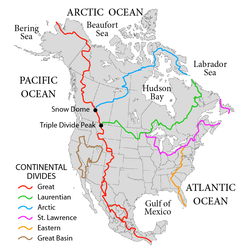
| Date | Event | Reference |
|---|---|---|
| May 2, 1670 | King Charles II of England grants the Hudson's Bay Company (HBC) a royal charter for "the sole Trade and Commerce of all those Seas, Streights, Bays, Rivers, Lakes, Creeks, and Sounds, in whatsoever Latitude they shall be, that lie within the entrance of the Streights commonly called Hudson's Streights... which are not now actually possessed by any of our Subjects, or by the Subjects of any other Christian Prince or State... and that the said Land be from henceforth... called Rupert's Land". Part of Rupert's Land covered part of today's Alberta. (The Milk river valley in the extreme south of the province and the north half of the province were not part of the Hudsons Bay watershed.) | [2] |
| 1715 | Captain Swan reports finding "gum or pitch" in the region now known as the Athabasca oil sand. The Captain's report is the first known to mention the oil sands. | [3] |
| September 11, 1754? | Anthony Henday, believed to be the first European to explore the area, enters present day Alberta. | [4] |
| 1778 | Peter Pond establishes the first fur trading post in Alberta [5] and submits a map of the area to the United States Congress and Lt. Governor of Quebec on March 1, 1785. [6] | [5] [6] |
| 1788 | Alexander Mackenzie mentions "bituminous" substances banking the Athabasca river. Mackenzie and Peter Pond found Fort Chipewyan. | |
| July 3, 1789 | Alexander Mackenzie embarks on his 1789 expedition to the Arctic Ocean from Fort Chipewyan. | |
| February 12, 1793 | Peter Fidler reports coal deposits on the banks of Kneehills Creek, near the Red Deer River, north of present-day Drumheller. Fidler is the first known to mention coal deposits on the Prairies. | [7] |
| 1795 | Fort Edmonton established by the HBC as a trading post at the present site of Fort Saskatchewan. | |
| December 20, 1803 | Mississippi drainage lands lying within present day Alberta are transferred to United States with the Louisiana Purchase, which was signed on April 30, 1803, comes into effect. | |
| October 10, 1812 | HBC factor Jame Bird marked out the layout of Fort Edmonton IV. This marked the start of recorded permanent human occupancy on the site of the present City of Edmonton. [8] | |
| October 18, 1840 | Robert Rundle arrives at Fort Edmonton as the first permanent cleric to the area. |

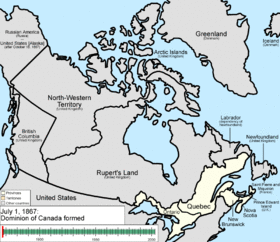

| Date | Event | Reference | |
|---|---|---|---|
| July 15, 1870 | The Prairies and Great Northland become part of the young country of Canada. Rupert's Land and the North-Western Territory are combined under the new name of the North-West Territories, parts of which will become part of Alberta. | [9] | |
| October 25, 1870 | Battle of the Belly River occurs. The battle is the last major conflict between the Cree (the Iron Confederacy) and the Blackfoot Confederacy, and the last major battle between First Nations on Canadian soil. | ||
| October 1, 1874 | First North-West Mounted Police outpost in Alberta at Fort Macleod is established. | ||
| September 1875 | Fort Brisebois, later renamed Fort Calgary in 1876 by James MacLeod, established by Éphrem Brisebois. | [10] | |
| August 23, 1876 | Treaty 6 receives its first signatories, ceding much of central Alberta to the crown. | ||
| September 22, 1877 | Treaty 7 is signed, ceding much of southern Alberta to the crown. | ||
| May 2, 1882 | North-West Territories, which then included the future land of Alberta, is divided into provisional districts, among them being the divisions of Alberta, Athabasca, Saskatchewan and Assiniboia. | [11] | |
| October 13, 1882 | Alexander Galt's company, the North Western Coal and Navigation Company, opens its first drift mine. The community of Coalbanks, later named Lethbridge, establishes itself around the mine. | [12] [ additional citation(s) needed ] | |
| August 10, 1883 | Canadian Pacific Railway (CPR) construction reaches Calgary, having entered Alberta in early May. | [13] | |
| 1883 | Langevin Siding, later renamed Carlstadt, and later Alderson, serves as the first discovery point for natural gas by CPR employees accidentally drilling for water. | [14] [ additional citation(s) needed ] | |
| April 2, 1885 | Frog Lake Massacre occurs as the North-West Rebellion stretches into modern day Alberta. Cree discontents kill nine white officials, instructors and priests living in the small settlement of Frog Lake (then, in the District of Saskatchewan). Perpetrators later hanged. | ||
| June 23, 1887 | Rocky Mountains Park (later renamed Banff National Park), is created by the Rocky Mountain Park Act . | [15] | |
| 1891 | Calgary & Edmonton Railway built, connecting Calgary to the south bank of North Saskatchewan River, opposite Edmonton. South Edmonton (later named Strathcona) grew up at the rail-head. | ||
| 1892 | Edmonton incorporated as a town. | ||
| January 1, 1894 | Calgary incorporated as a city. | [10] | |
| November 7, 1898 | Klondike Trail construction is started by Thomas Chalmers on behalf of the North-West Territorial government. He worked on stretch of trail between Fort Assiniboine and Lesser Slave Lake. Edmonton at the time was the starting point for many who attempted the overland trek to the Yukon goldfields. | [16] | |
| June 21, 1899 | Treaty 8 is signed, ceding much of Northern Alberta to the crown. | ||
| April 29, 1903 | Frank Slide, Canada's deadliest rockslide occurs in the town of Frank, then North-West Territories. | ||
| November 7, 1904 | Edmonton incorporated as a city. | [17] | |
| September 1, 1905 | The Alberta Act creates Alberta as a province from the North-West Territories. | ||
| November 9, 1905 | 1st Alberta general election occurs, the Alberta Liberal Party defeats the Alberta Conservative Party led by R.B. Bennett. Bennett will become the 11th Prime Minister of Canada. | ||
| 1907 | Strathcona incorporated as a city. | ||
| January 11, 1911 | Lowest temperature every recorded in Alberta, -60.6 °C at Fort Vermillion. | ||
| September 3, 1912 | Alberta Legislature Building opened by Governor General of Canada, the Duke of Connaught. | [18] | |
| 1912 | The cities of Edmonton and Strathcona amalgamated. | ||
| May 14, 1914 | A.W. Dingman struck wet natural gas at Turner Valley, which produced gasoline. The Turner Valley/Black Diamond oil field became a major supplier of oil and gas and the largest producer in the British Empire. [19] | ||
| June 19, 1914 | Hillcrest mine disaster, Canada's deadliest coal mining accident killing 189 workers. | ||
| July 21, 1915 | 1915 Alberta liquor plebiscite occurs with 61% voting in favour of prohibition. | [20] | |
| April 19, 1916 | Women's suffrage movement prevails in Alberta, women earn the right to vote, being the third province to grant the right with the passage of the Equal Suffrage Statutory Law Amendment Act. | [21] | |
| 1917 | Louiske McKinney and Roberta MacAdams elected to the Alberta Legislature, the first women elected to government in the British Empire. | ||
| October 2, 1918 | Spanish Influenza causes the Alberta Board of Public Health to declare all citizens be masked in public. Around 4,700 people die and over 31,000 cases are reported in Alberta. | [22] [23] | |
| July 18, 1921 | 5th Alberta general election occurs, the United Farmers of Alberta defeats the incumbent Liberal government. | ||
| November 5, 1923 | 1923 Alberta prohibition plebiscite occurs. 58% voted in favour of clause (d), enabling government sale of liquor and private operation of beerhalls, and ending the Prohibition that had been in effect since 1916, following the 1915 Prohibition plebiscite. | [24] | |
| June 16, 1926 | The City of Edmonton receives a licence to operate airport, later named Blatchford Field, the first municipal airport in Canada. | [25] | |
| April 24, 1928 | Edwards v Canada decision is released, favouring the all-Albertan group, the Famous Five. The decision decides women are persons under the law and thus could be appointed to the Senate. | [26] | |
| December 14, 1929 | Alberta Natural Resources Act passed, transferring control of natural resources and Crown land to the province. | [27] | |
| July 2, 1934 | Brownlee sex scandal, captures widespread attention in the province, resulting in the premier's resignation. | [28] | |
| 1935 | The UFA government was defeated in the 1935 election by William Aberhart's Social Credit party. This was the first Social Credit government elected anywhere in the world. | ||
| September 29, 1938 | Alberta Treasury Branches established as a provincially owned bank, as part of the Social Credit government's monetary reform policies. | ||
| 1939-1945 | Alberta plays a role in the WWII Allied war effort. This includes participation in the Commonwealth Air Training Plan, base and administrative headquarters for construction of the Alaska Highway, and hundreds of planes being ferried through Alberta to go to aid the Soviet Union's war effort. |

| Date | Event | Reference |
|---|---|---|
| February 13, 1947 | Leduc No. 1, the first major oil discovery in northern Alberta is made, growing the petroleum industry in Alberta. | |
| August 30, 1971 | 17th Alberta general election occurs. The Progressive Conservatives win a majority, led by Peter Lougheed — ending 36 years of the Social Credit party's successive victories and grip on majority power in the Legislature. | |
| May 19, 1976 | Alberta Heritage Savings Trust Fund created upon Alberta Heritage Savings Trust Fund Act receiving royal assent. The Heritage fund remains the only sovereign wealth fund in Canada. | [29] |
| October 28, 1980 | National Energy Program is announced by the federal Trudeau government, creating anger and resentment in the West and set to take effect on January 1, 1981. | [30] |
| September 15, 1981 | West Edmonton Mall, at the time the world's largest, opens. | |
| September 25, 1985 | Royal Tyrell Museum of Palaeontology opened. | |
| February 8, 1986 | The Hinton train disaster kills 23 people, the deadliest railway accident in Alberta history. | |
| June 14, 1986 | The Mindbender derails, killing three people | |
| July 31, 1987 | The Edmonton tornado killed 27 people and caused more than $330M in damage. | |
| February 13, 1988 | 1988 Winter Olympics open in Calgary with closing ceremonies on February 28. | |
| June 19, 2013 | 2013 Alberta floods begins, causing some of the worst flooding damage in Alberta's history. | |
| May 5, 2015 | 29th Alberta general election occurs. The Alberta New Democratic Party win a majority — ending 44 years of Progressive Conservative party's successive victories (since the 1971 election). | |
| May 1, 2016 | 2016 Fort McMurray wildfire begins. It would displace more than 88,000 people from their homes. | |
| December 2, 2018 | Rachel Notley#Oil_curtailments announced to take effect in January 2019, limiting production to 3.56 million barrels per day. | |
| April 16, 2019 | 30th Alberta general election occurs. The United Conservative Party win a majority, displacing the incumbent majority government of Alberta NDP after one-term. | |
| January 8, 2020 | The shoot-down of Ukraine International Airlines Flight 752 in Iran kills 51 Canadians, including 13 Edmontonians, of whom 10 were faculty at the University of Alberta. This is believed to be the most Edmontonians killed in a single event since the 1987 tornado, and deadliest day in the history of the university. | |
| February 23, 2020 | Teck Resources withdraws its application to build the Frontier Mine in northern Alberta despite having spent more than one billion dollars over then ten years on the project. | |
| March 17, 2020 | COVID-19 causes the government of Alberta to declare a state of emergency. [31] The first person in Alberta dies from the virus on March 19. [32] | |
| September 30, 2022 | On National Day for Truth and Reconciliation, the Alberta government and Manitou Asinîy-Iniskim-Tsa Xani Centre committed to returning the Manitou Stone (Creator Stone), a 145 kg meteorite, to its landing site near Hardisty. A $7.5-10 million geodesic dome designed by Indigenous architect Douglas Cardinal, will be a prayer healing facility and vesicle for the allegedly sacred stone. Former Poundmaker Chief Blaine Favel said land for the site and funding from corporate donors was being negotiated. The Royal Alberta Museum will continue to curate the artifact until the site is constructed. [33] |
 |

Alberta is one of the thirteen provinces and territories of Canada. It is a part of Western Canada and is one of the three prairie provinces. Alberta borders British Columbia to the west, Saskatchewan to the east, the Northwest Territories to the north, and the U.S. state of Montana to the south. It is one of the only two landlocked provinces in Canada, with Saskatchewan being the other. The eastern part of the province is occupied by the Great Plains, while the western part borders the Rocky Mountains. The province has a predominantly continental climate but experiences quick temperature changes due to air aridity. Seasonal temperature swings are less pronounced in western Alberta due to occasional Chinook winds.

The Hudson's Bay Company is a Canadian retail business group. A fur trading business for much of its existence, it became the largest and oldest corporation in Canada, and now owns and operates retail stores across the country. The company's namesake business division is Hudson's Bay, commonly referred to as The Bay.

Fort McMurray is an urban service area in the Regional Municipality of Wood Buffalo in Alberta, Canada. It is located in northeast Alberta, in the middle of the Athabasca oil sands, surrounded by boreal forest. It has played a significant role in the development of the national petroleum industry. The 2016 Fort McMurray wildfire led to the evacuation of its residents and caused widespread damage.
Peter Pond was an American explorer, cartographer, merchant and soldier who was a founding member of the North West Company and the Beaver Club. Though he was born and died in Milford, Connecticut, most of his life was spent in northwestern North America, on the upper Mississippi and in western Canada.

Imperial Oil Limited is a Canadian petroleum company. It is Canada's second-largest integrated oil company. It is majority-owned by American oil company ExxonMobil, with a 69.6% ownership stake in the company. It is a producer of crude oil, diluted bitumen, and natural gas. Imperial Oil is one of Canada's major petroleum refiners and petrochemical producers. It supplies Esso-brand service stations.
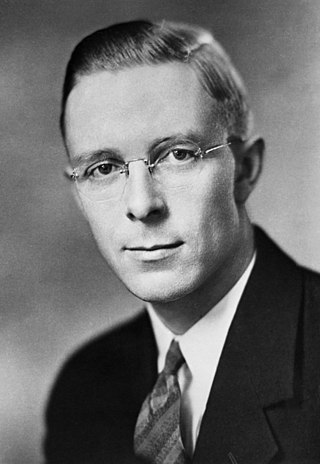
The 1967 Alberta general election was held on May 23, 1967, to elect members of the Legislative Assembly of Alberta to the 16th Alberta Legislature. The election was called after the 15th Alberta Legislature was prorogued on April 11, 1967, and dissolved on April 14, 1967.
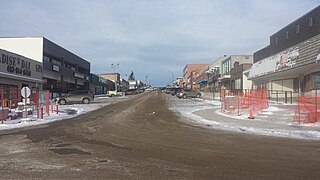
Rocky Mountain House is a town in west-central Alberta, Canada. It is approximately 77 km (48 mi) west of Red Deer at the confluence of the Clearwater and North Saskatchewan Rivers, and at the crossroads of Highway 22 and Highway 11. The surrounding Clearwater County's administration office is located in Rocky Mountain House.

The 18th Alberta Legislative Assembly was in session from May 15, 1975, to February 14, 1979, with the membership of the assembly determined by the results of the 1975 Alberta general election held on March 26, 1975. The Legislature officially resumed on May 15, 1975, and continued until the fourth session was prorogued on November 3, 1978 and dissolved on February 14, 1979, prior to the 1979 Alberta general election on March 14, 1979.

Alberta has been a tourist destination since the early days of the 20th Century, with attractions including national parks, National Historic Sites of Canada, urban arts and cultural facilities, outdoor locales for skiing, hiking and camping, shopping locales such as West Edmonton Mall, outdoor festivals, professional athletic events, international sporting competitions such as the Commonwealth Games and Olympic Winter Games, as well as more eclectic attractions.

The North Saskatchewan River is a glacier-fed river that flows from the Canadian Rockies continental divide east to central Saskatchewan, where it joins with the South Saskatchewan River to make up the Saskatchewan River. Its water flows eventually into the Hudson Bay.
Ronald Liepert is a Canadian politician from Alberta who serves as the Member of Parliament for Calgary Signal Hill in the House of Commons of Canada. He previously served in the Cabinet of Alberta as Minister of Finance, Energy, Health and Wellness and Education under premiers Ed Stelmach and Alison Redford. From 2004 to 2012, he was a Member of the Legislative Assembly of Alberta, representing the constituency of Calgary-West, as a Progressive Conservative legislator. On April 12, 2014, Liepert won the federal Conservative nomination in Calgary Signal Hill, defeating incumbent Rob Anders, and was elected to parliament in 2015. He was re-elected in 2019 and 2021.

Alberta Investment Management Corporation (AIMCo) is a Canadian Crown corporation and institutional investor established to manage several public funds and pensions headquartered in Edmonton, Alberta. AIMCo was established by an act of the Legislative Assembly of Alberta in 2008 under the government of Progressive Conservative Premier Ed Stelmach.

The Alberta Heritage Savings Trust Fund(HSTF) is a sovereign wealth fund established in 1976 by the Government of Alberta under then-Premier Peter Lougheed. The Heritage Savings Trust Fund was created with three objectives: "to save for the future, to strengthen or diversify the economy, and to improve the quality of life of Albertans." The operations of the Heritage Savings Trust Fund are subject to the Alberta Heritage Savings Trust Fund Act and with the goal of providing "prudent stewardship of the savings from Alberta's non-renewable resources by providing the greatest financial returns on those savings for current and future generations of Albertans." Between 1976 and 1983 the Government of Alberta deposited a portion of oil revenue into the fund. The Heritage Savings Trust Fund used oil revenues to invest for the long term in such areas as health care, education and research and as a way of ensuring that the development of non-renewable resources would be of long-term benefit to Alberta. The strategy and goals of the fund have changed through successive provincial governments which moved away from direct investments in Alberta to a diversified approach, which now includes stocks, bonds, real estate and other ventures.
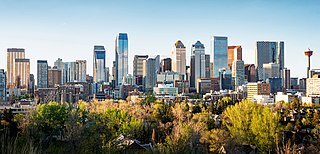
Calgary is the largest city in the Canadian province of Alberta. It is the largest metro area within the three Prairie Provinces region. As of 2021, the city proper had a population of 1,306,784 and a metropolitan population of 1,481,806, making it the third-largest city and fifth-largest metropolitan area in Canada.

The Mackenzie River in Canada's Northwest Territories is a historic waterway, used for centuries by Indigenous peoples, specifically the Dene, as a travel and hunting corridor. Also known as the Deh Cho, it is part of a larger watershed that includes the Slave, Athabasca, and Peace rivers extending from northern Alberta. In the 1780s, Peter Pond, a trader with the North West Company became the first known European to visit this watershed and begin viable trade with the Athapascan-speaking Dene of these rivers. The Mackenzie River itself, the great waterway extending to the Arctic Ocean, was first put on European maps by Alexander Mackenzie in 1789, the Scottish trader who explored the river. The watershed thus became a vital part of the North American fur trade, and before the advent of the airplane or road networks, the river was the only communication link between northern trading posts and the south. Water travel increased in the late 19th century as traders, dominated primarily by the Hudson's Bay Company (HBC), looked to increase water services in the Mackenzie River District.

The first inhabitants hunted and gathered in the area that is now Edmonton, Alberta, Canada, around 3,000 BC and perhaps as early as 10,000 BC, when an ice-free corridor opened up as the last ice age ended and timber, water, and wildlife became available in the region.
The timeline of Edmonton history is a chronology of significant events in the history of Edmonton, Alberta.
The following is a bibliography of Alberta history.

Below is a brief timeline covering the history of the petroleum industry Alberta and its predecessor states.
On October 18, 2021, a referendum was held in Alberta, Canada on two questions, whether equalization payments should be eliminated from the Constitution of Canada, and whether the province should observe daylight saving time year-round. The referendum was held as part of the 2021 Alberta municipal elections and the Senate nominee election.